PcW 16 'Anne'
The first quick pictures of the last model of the PCW series: not nicknamed 'Joyce' but 'Anne'. Not equipped with CP/M but with a dedicated graphical user interface, GUI, called 'Rosanne', written by Creative Technology, makers of among others MicroDesign, The Network and several other great programs. This model was the last PCW missing from the collection from the Joyce Computer Club and is not yet familiar ground (to me).
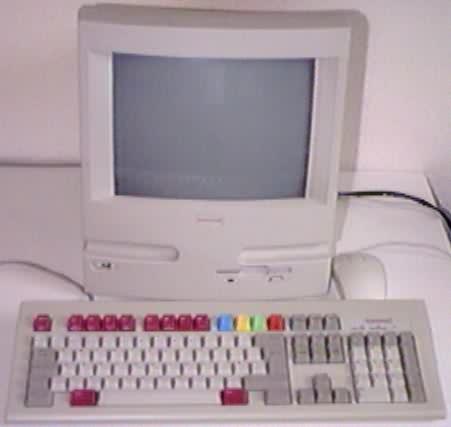
The PcW16 might be compared to an Apple Macintosh. From the outside, that is, inside the specifications compare better to the Joyce's. Logical as this may sound, there are huge differences and it is not compatible with the earlier models. The designation PcW (no capital 'c') gives away that it uses a 3.5" drive, but it is a 1,44mb high-density PC type drive rather than the 720kb DD model(s) of the Joyce. And it reads and writes PC discs without conversion programs!
Another big difference can be found in the processor. Still a Zilog Z80 but running on 16MHz rather than 4MHz. The increase in speed was a must in view of the new software.
Because that is where the most significant differences can be found. Old-time companions LocoMotive and Digital Research did not attribute to designing the software for the '16'. The operating system no longer uses a command prompt but has a true graphical user interface (requiring more MHz's) and was written by Creative Technology. It normally does not run CP/M or LocoScript programs, but a CP/M emulator, ZP/M, is freely available. You could consider ZP/M an improved version of CP/M and it runs all of the programs that Joyce-models can run indeed: ZP/M is even available for the Joyce as well. But it is a different operating system!
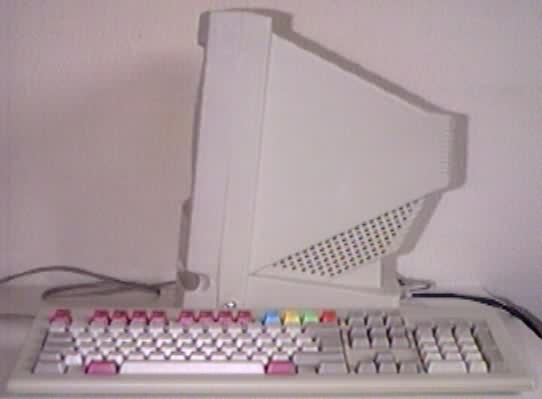
The side of the PcW 16 shows its resemblance to the PcW 9256 and PcW 10: the back casing is of similar design. In fact only the front case is of new design...
The colourful keyboard is a remarkable item too: as with the other PCW's and PcW's it is dedicated to the computer. Although of standard PS/2 type and compatible with other manufacturers you would have a hard time remembering the different labelling of the keys when operating a keyboard from e.g. IBM.
As with almost any other GUI software it comes with a mouse that also should be of standard Microsoft/PC type (PS/2 connector) but rumour has it that it will not always work... My original does not work yet but I will (try to) fix that as soon as possible. As soon as I have replaced the drive that is definitely malfunctioning: only then will I be able to run the rescue disc that came with it (in order to fix the mouse).
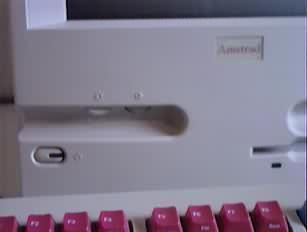
The left side of the front case of the PcW16, with the left groove that distinguishes it from the 9256 and 10 models. Along with the fact that the vertical left and right lines of the front cover run down all the way without an interruption that should mark out an imaginary PC-styled system case.
I call it the 'Apple look': there are some parallels to be found between this Amstrad and the Apple indeed. They both fill a niche and use dedicated hard and software. I should also add that there are a lot of differences too. First of all, Amstrad always aims their products at 'value for money' and admittedly, sometimes economises on parts and features, causing compatibility problems. Apple aims at the high end of the market and goes for quality all the way. Having said that I may add that their computers are pretty expensive and also have compatibility problems (when you look at computers from a PC/Windows point of view).
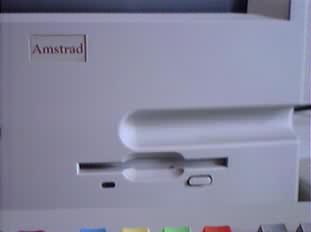
The right side of the front cover with the Amstrad brand label and the 1,44mb 3.5" HD disc drive. The drive is a standard one with a standard connection: which is fortunately because mine is not working properly, so I will have to replace it. The drive can read and write PC formatted discs, both 1,44mb as well as 720kb discs. In order to read 3.5" discs from earlier PCW's you would have to use conversion software (unavailable for Anne, but you could use a PC as an intermediary) or the CP/M emulator. The default layout of a disc formatted on an Anne equals the Cabinet (the flash disc memory). When the disc is read on a PC it displays the directories 1 to 16 plus a system directory.
The nickname Anne would originate from the name of the operating system, Rosanne, I guess. In line with the Joyce's, also a female nickname but sufficiently different to outline that it is a different and incompatible computer. The '16' in the name refers to the processor frequency of 16 MHz. According to the definition it still is an 8-bit home computer rather than a 16 (or more) bits personal computer but in respect of storage capacity, communication ports and consumables it is more PC than Joyce compatible. It no longer has a dedicated printer and even uses some standard components like the keyboard (although customised to match the software) and the mouse.
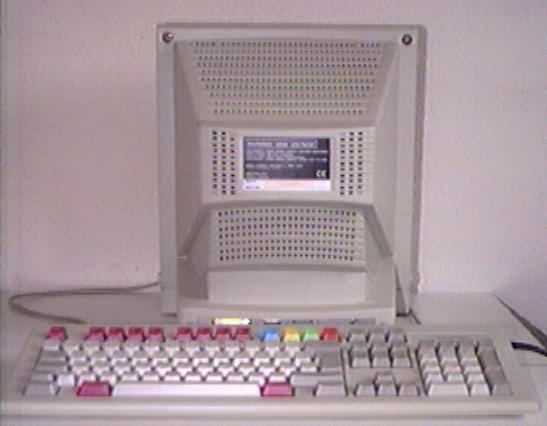
The backside of the machine is a regular 9256/10 cover look-alike, except that the outer vertical lines (as mentioned before) are more of a Macintosh style.
The monitor case does not provide for the possibility to place a printer on it. That does sound logical in view of the fact that Anne does not have a dedicated printer but uses a standard Centronics printer (or even a serial one, as that port is also available).
Provided for that and the fact that the keyboard is the normal size of a PC keyboard (much like the PCW 9512 and PcW 9512+, although these use XT/84 keyboards and Anne's keyboard is an AT/102 keyboard) the PcW 16 is still a small and elegant design. It will still appeal to users that do have ample workspace...
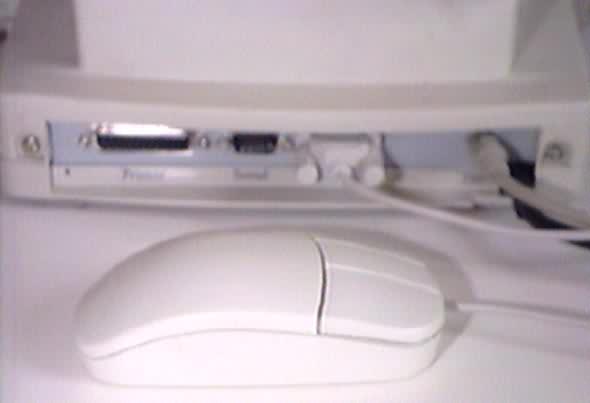
The three-button mouse in close-up with the communication ports in the background. The mouse uses a standard serial port and has a MS/PC mode switch, thus indicating that it could be PC-compatible (I did not test this yet). The screws allow for a solid connection.
The keyboard featuring 102 keys, plugs in using a standard PS/2 connector on the back and is compatible indeed, though it should be noted that the Rosanne software keeps on requesting you to hit the 'yellow' key or to use the mouse! Fortunately (and that does depend on your taste and experience) most shortcuts correspond to the Windows convention.
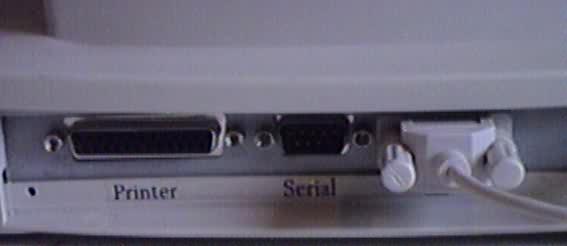
The available ports in close-up: a standard Centronics parallel printer port (fortunately a market standard IBM female connector too) and a 9-pin serial port, also a standard connector.
So far I do not have gained experience with printing (and especially with printer driver programs available for the PcW16) but I expect some difficulties in that field. Anne's are much less widespread than Joyce's and are consequently less supported by printer manufacturers and software houses. ZP/M should be no problem but the Rosanne software provided with the 16 will not be supported to that extent. The PcW 16 has drivers for three basic classes of printer: laser printers, inkjet printer and 24-pin matrix printers. The supported emulation types are Hewlett Packard PCL Level 5, Epson LQ, Canon BJ and IBM X24E. Besides these general emulation types a couple of printer models can be selected specifically: the OKI LED series, Canon BJ-30, Epson Stylus (ESC/P) printers, HP Deskjet printers, and Epson LQ1500. Support does not include daisy wheel or 9-pin matrix printers.
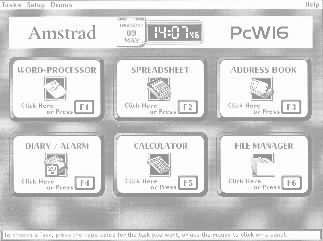
The operating system, Rosanne, has a true graphical user interface (a GUI, like Windows or Apple's System7) and has some programs built into the machine. Supplied are a word processor, spreadsheet, address book, diary/alarm, calculator and file manager. This software is normally always available and booting the machine does not require a disc, just switching it on will result in the appearance of the desktop (the boot).
This booting process is fast: about 20 seconds, depending whether it is a 'cold' or 'warm' boot. For a cold boot the 16 will check its memory first, something it does not when the power was still switched on and the LED on the front panel was red.
The desktop can be operated by means of the mouse or by pressing the (coloured) hotkeys on the keyboard. Starting the programs is fast (at 16mHz, four times the speed of a Joyce but with the heavier 'overhead' of a GUI) when compared to the older PCW's and the programs have a comfortable feeling. Working with it is also reasonably fast: it has a 1-megabyte flash drive (a non-volatile RAM disc) that allows for fast storage. Corruption in the flash drive, called the 'cabinet', is the main cause for operational errors: the machine comes with a rescue disk, which will refresh the system files in the cabinet. This cabinet works as fast as a RAM disc but has the big advantage that files are still available when the power has been switched off and on. Screen display and scrolling is a bit less fast but still comfortable to work with. The monitor itself is of a good working quality.
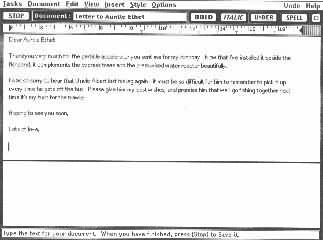
The word processor supplied with Rosanne is a nameless one and is much more WYSIWYG (what you see is what you get) than LocoScript is. Larger fonts are displayed on scale as well: headers and footers are not displayed, however. The program requires naming the document up-front as well as LocoScript does and uses pull-down menus too, but there are some changes and improvements. The menu use of function keys has been replaced by the Windows convention to underline a letter in the menu option that will function in combination with the [ALT] key. [ALT][S][I], for instance, is the equivalent of [+][I] for italic text.
Using the cursor keys left/right within a menu you can jump to the next drop down window, a feature that will shorten operating the menus. The word processor can be operated through these hotkeys entirely but of course the mouse would normally be the pointing device used... Mine does not function yet: I guess it will be my first experience in using the rescue disk. Simple as operation may appear from the poor quality pictures: the operation may be so, but the functionality is not. I have not examined the word processor to its full capacity yet but there is a lot 'below the surface', that I do know!
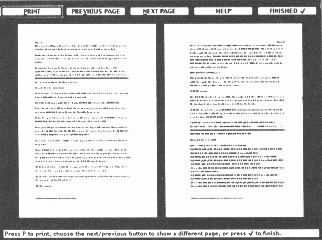
The picture on the right shows a definite improvement: a print preview (of multiple pages). WYSIWYG may sound to be everything you would want, but headers and footers, for instance, are not included in the editing mode. And, a print preview will present you with a neat overview of the (completed) document. It was one of the few functions I missed dearly in LocoScript.
Contrary to what you would expect from a graphical program Rosanne's word processor cannot work with graphics or pictures. But the output on screen looks pretty impressive.
However, the actual result will depend on the support of the printer used and the printer driver used - that is an issue I have not tested yet! A subject that is to be continued upon. I have a HP LaserJet III (an older laser printer) and a Hewlett Packard 895Cix (a more recent printer, an inkjet from the DeskJet series) I want to experiment with. I have my doubts on that respect, as well as the reliability of the system that is rumoured to be much less than the older machines. But, like I said before, I do not have sufficient experience with this computer yet to judge it. My present problems with the mouse and drive can be due to transportation and age.
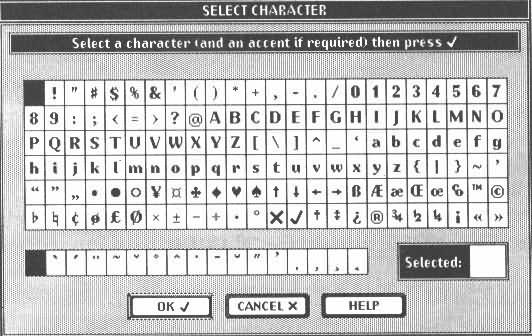
Definitely bad news, however, is the character set: though the menu on the left looks easy to handle and I guess you could derive the way to deal with foreign accents from merely looking at the picture, without having to refer to the manual, it also indicates a great disadvantage...
The PcW 16 seems restricted to the 256 characters as used in ordinary word processors. A huge difference from the 600, or so, characters as available in LocoScript as from version 2. But then again, such a powerful program would have called for a dedicated printer once more, loosing the benefits of the market standard (cheap and readily available hardware and consumables). Plus: as many PCW-users have experienced, the printer is the usually the first part of the equipment that wears, breaks down or simply becomes old-fashioned and outdated. And it would have caused the same conversion problems that LocoScript user's face when they want to export documents to another system or program. There is always a second side to a coin: when used as a true stand-alone I would prefer LocoScript on first sight but the improvements of the PcW 16 mainly concern its compatibility with the PC and consumables. The subject of data-compatibility and possible conversion required for the data-exchange with a program like Word for Windows is also one of the issues to be examined.
The machine, its storage and other facilities, plus the Rosanne software and the ZP/M emulation of CP/M are still new to me. I will, no doubt, have a great time investigation the possibilities of the Anne: it is a different machine than the Joyce entirely. I guess this page will be expanded pretty soon. If I can manage to keep other JCC-members at bay! Do consult the links page on other URL's for the PcW 16: this page is nothing more than a first impression only...